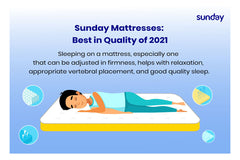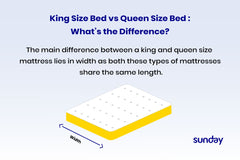
Share about us & get a complimentary Sunday Delight Pillow
As simple as, click on the "share now", share & getting the goodies
 By Alphonse Reddy
By Alphonse Reddy 4 Comments
4 Comments
Ever wondered what is in a latex mattress? You’re in luck – our mattress guide offers a complete explanation of everything you need to know about latex mattresses. It might surprise you to learn that the key component of latex is a natural product and one which has served to provide comfort at nighttime for years. But what is in a latex mattress?
In short, latex is a type of milk which comes from the rubber tree. When this is converted into latex foam, it creates the spongey, durable and comforting substance that goes into mattresses. In this guide, we’ll explain in simple terms everything you need to know about the product, including:
With that in mind, let’s begin to truly understand what is in a latex mattress, by looking in detail at the nature of the product and how it’s used in various different ways.
Latex is effectively the sap which is taken from rubber trees. These are grown for five years before their bark is slowly removed. This disrupts the ducts which carry their sap, causing the latex (a white, milky substance at this point) to escape.
Collection cups are placed below the trees, with the latex pouring into them. These are then deposited into larger tanks, which are processed (usually coagulated using formic acid) to create the elastic material we are more familiar with.
Asia is the main source of latex at this point, despite the material originating in South America. Numbers of the plant have decreased in this area as a result of leaf blight, which primarily affects rubber trees.
Interestingly, Christopher Columbus is credited with the initial discovery of latex – when he saw Haitian children playing with a bouncy rubber ball. This was named “Caw-Uchu”, or “weeping wood” – owing to the manner in which the raw substance is attained from a tree.
From here the world would continue to dabble in the use of this form of rubber, with Joseph Priestly creating the first eraser in 1770, and an unnamed Scotsman patenting the waterproof raincoat late into the nineteenth century.
Charles Goodyear arguably made the biggest step forward, when he used Sulphur “dust” to vulcanize the material. This meant that it was able to withstand the pressures of immense heat – meaning it could be used to create tires. Goodyear is still a world-renowned brand today.
As is the case with any natural resource, limited supplies are a factor. As such, efforts have been made to try and protect rubber trees going forwards. This has seen scientists collecting seedlings and cultivating them in an artificial environment. These have also been produced with the intention of making the stumps “fatter” – as a means of trying to produce more latex.
By growing these trees in an (initially) artificial environment, it should ensure rubber trees remain un-endangered heading forwards.
As you may have already realised, owing to the way in which it’s produced, latex is very different in composition to memory foam. We’ve already looked at what latex is and how it’s produced – but what about memory foam?
Whereas latex is a natural product, memory foam is technologically produced. Polyurethane is mixed with a series of other chemicals to create the substance used in mattresses. “Other chemicals” sounds like a vague description, but this is because the exact substances used in a mattress are considered a trade secret and unavailable for public use.
The debate over whether a latex or memory foam mattress is better has raged for years. While a conclusive answer will never be found, there are without question a number of benefits which latex mattresses offer.
Just some of these include:
With these points in mind, it’s fairly easy to see why so many people opt for latex over memory foam.

Aside from being used in mattresses, latex has a number of other purposes. As a considerably durable product, you’ll find latex comes in handy in a series of different products. Just some of these include:
These are just a handful of the many different uses latex has. The material’s versatility when it comes to size, shape and texture lends it to being used in a variety of areas.
When latex is produced, you’ll find there are two different types that can be manufactured. These are known as either Talalay or Dunlop (sometimes extended to Dunlopillo to avoid confusion with the brand of tyres).
There are subtle differences between the two in the way they’re produced:

Naturally, owing to the varying methods of creation, there are noticeable differences between how the finished product looks and feels. While they’re ultimately both mattresses, serving the same purpose, seasoned pros will be able to notice the difference.
Some of these variations include:
If you’re interested in ensuring you get a certain type of latex mattress for your bed, it’s worth asking which type of material it’s made out of.
There is naturally no definitive answer to this question. Lots of factors will impact the lifespan of a mattress, including:
That said, an all-natural latex mattress is capable of lasting up to 20 years if it’s properly taken care of.
It might also be worth checking out your body mass index prior to buying a mattress. This will let you know what kind of size and level of comfort will be best for you. If you are of a stockier build, it might be worth investing in Dunlop, owing to the durability factor.

It’s not as easy as picking a basic level of thickness when it comes to selecting your mattress. Density and hardness are important factors that need to be taken into account when choosing your bedding.
Mattress Density – Means the amount of material used in certain areas, and contributes to firmness. The more material used, the firmer the mattress will be.
Mattress firmness – Is the name that is given to the ability a mattress has to provide resistance when you put pressure on it. The more you feel the latex core pushing back against you, the harder the mattress is.
These combine together to create an overall firmness level. There are several different formulas which can be used to determine this. Once they’ve been worked out, they’ll be assigned an overall “score”. Generally speaking, this will be represented as:
If you’re unsure of these kinds of specifications, it might be a wise idea to just ask for the basic “soft”, “medium” and “firm” sizes. If you feel more confident, bring up the kPas.
We hope you now have a much better understanding of what is in a latex mattress. If you’re interested in using one for your bed, make sure to get in contact with a member of the Sunday Rest team. We have high-quality latex mattresses, ready to be enjoyed and relaxed on in the near future.

Sleeping position in Islam Sleep science has been gradually building momentum over the past couple...

Mattresses are known to improve sleeping postures and circulation, which is essential for a healthy...

Everyone looks for comfort when it comes to sleeping and relaxing. And mattresses play a...

Choosing the correct type of mattress is the first step if you want a luxurious...

The world of mattress sizes can get your mind out of whack if not adequately...
Still confused? Call us on 080 4749 4649


Comments
Waw sooper description. And i want bed talalay latex bed topper 2 inch. 3.5 kpa. King size
Are your latex plus mattresses made of Talalay or Dunlop?…. Please tell me, I want to buy one.
pl info which is best natural latex mattress or hybrid mattress (made of foam plus latex) . which is best ?? any show room in hubli .
I want to buy 84*60*10*mattress